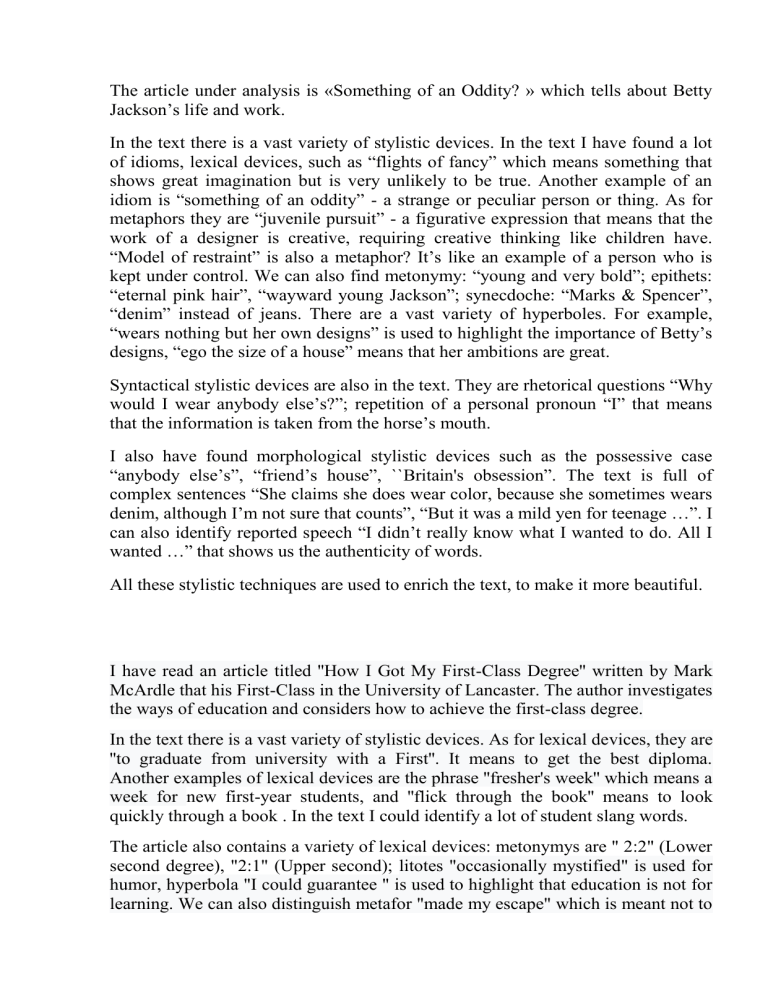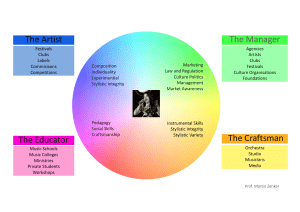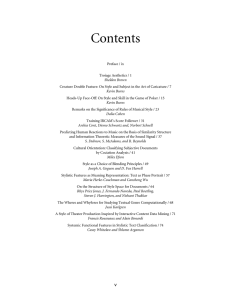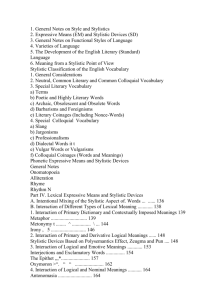
The article under analysis is «Something of an Oddity? » which tells about Betty Jackson’s life and work. In the text there is a vast variety of stylistic devices. In the text I have found a lot of idioms, lexical devices, such as “flights of fancy” which means something that shows great imagination but is very unlikely to be true. Another example of an idiom is “something of an oddity” - a strange or peculiar person or thing. As for metaphors they are “juvenile pursuit” - a figurative expression that means that the work of a designer is creative, requiring creative thinking like children have. “Model of restraint” is also a metaphor? It’s like an example of a person who is kept under control. We can also find metonymy: “young and very bold”; epithets: “eternal pink hair”, “wayward young Jackson”; synecdoche: “Marks & Spencer”, “denim” instead of jeans. There are a vast variety of hyperboles. For example, “wears nothing but her own designs” is used to highlight the importance of Betty’s designs, “ego the size of a house” means that her ambitions are great. Syntactical stylistic devices are also in the text. They are rhetorical questions “Why would I wear anybody else’s?”; repetition of a personal pronoun “I” that means that the information is taken from the horse’s mouth. I also have found morphological stylistic devices such as the possessive case “anybody else’s”, “friend’s house”, ``Britain's obsession”. The text is full of complex sentences “She claims she does wear color, because she sometimes wears denim, although I’m not sure that counts”, “But it was a mild yen for teenage …”. I can also identify reported speech “I didn’t really know what I wanted to do. All I wanted …” that shows us the authenticity of words. All these stylistic techniques are used to enrich the text, to make it more beautiful. I have read an article titled ''How I Got My First-Class Degree'' written by Mark McArdle that his First-Class in the University of Lancaster. The author investigates the ways of education and considers how to achieve the first-class degree. In the text there is a vast variety of stylistic devices. As for lexical devices, they are ''to graduate from university with a First''. It means to get the best diploma. Another examples of lexical devices are the phrase ''fresher's week'' which means a week for new first-year students, and ''flick through the book'' means to look quickly through a book . In the text I could identify a lot of student slang words. The article also contains a variety of lexical devices: metonymys are " 2:2" (Lower second degree), "2:1" (Upper second); litotes "occasionally mystified" is used for humor, hyperbola "I could guarantee " is used to highlight that education is not for learning. We can also distinguish metafor "made my escape" which is meant not to do unnecessary work or comparison "lecturers as customers". The author also uses personification "the university wants from you". There are syntactical devices such as inversion "and nor should you"; rhetorical questions "What does the lecturer want?" , "what did we know?". In the article repetition of Imperative sentences in direct speech is used to show how it is important to keep to author's advice. Repetitions are "I didn't give up", "I didn't attend every lecturer", "I didn't get 80%". Repetition of pronoun "I" is used to show that the author did it. All these devices helps the author to express the main idea of the article ho to get success in studying. The title of the text is “Fahrenheit 451” written by Ray Douglas Bradbury. To begin with, there are a lot of lexical devices. There are some personifications such as “the alarm sounded”, “the bell kicked itself”. We can also identify hyperbola: “kicked itself two hundred times”. The author shows irritation of these sounds. “Flurry of snow” is also a hyperbola that highlights the amount of the snow. Another example of hyperbola is “seemed to be the only thing holding it in the sky. We can also find a comparison “like a man in a dream”. “They fell like slaughtered birds and the woman stood below, like a small girl, among the bodies” – this sentence is built by comparison. The text is full of epithets: “their mighty metal thunder!”, “a flaking three-storey house”, “a thin fireproof plastic sheath”. Some metaphors: “silver hatchets” and “Books bombarded his shoulders” are used in figurative meaning and “it blazed in his mind for the next minute” means that the thought was stuck in his mind. “A book alighted, almost obediently, like a white pigeon, in his hands, wings fluttering” is rather interesting sentence, I think, because it is full of various devices. First of all, I has personification “book alighted” which means that the character got it. Then comparison “like a white pigeon”. And we can find Participle 1 and inversion in one phrase “wings fluttering”. As for morphological devices, they are a direction speech: “Montag, you forgot your helmet!”, “Here we are!”, “Enough of that!” said Beatty”. Doing this, the author make us sure of the authenticity of the characters` speech. We can identify possessive case: “woman’s eyes”, or “Montag’s hand”. Imperative mood “Look here!”, “Montag, up here!”. So, as we can see the text is full of various stylistic devices: lexical, syntactical and morphological. All of them make the text vivid and fascinating. In this piece of the text we can find different stylistic devices. For example, “second contender for the world karate championship” is a periphrasis because instead of using “the man” or “the person” the author has used such a long phrase to deepen our knowledge of that person. We can also find a metaphor “glided”. It is used figuratively and means “to go”. The author wanted to emphasize that the person walked quietly, noiselessly. There is the epithet “the tall well-muscled manager”, “menacing inscrutability”, “formidable allegiance”. It is used here to сause a certain emotional attitude towards the subject. It is also worth adding that the last two epithets are unassociated ones as they ascribe such qualities to objects which are not inherent in them.




